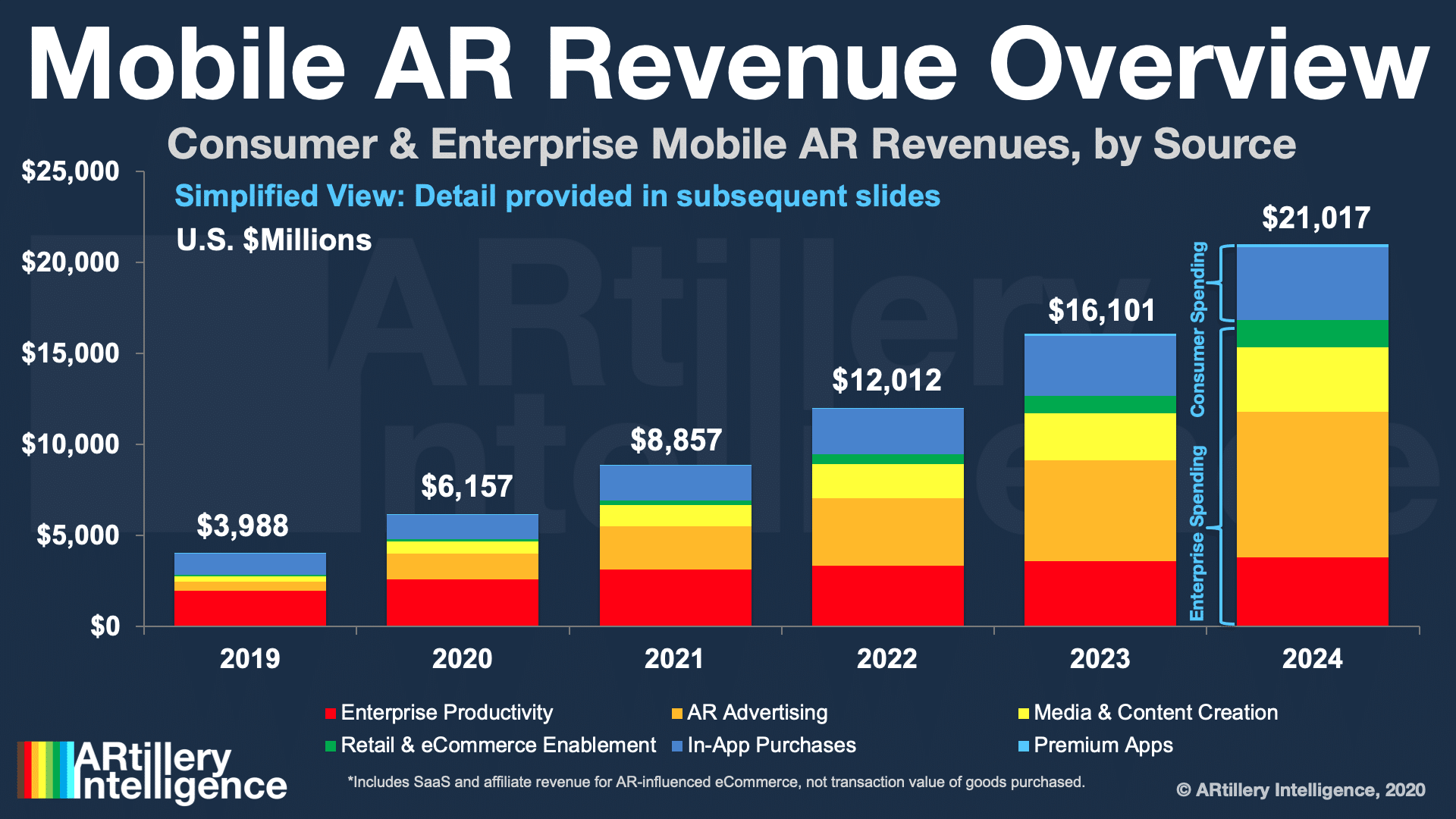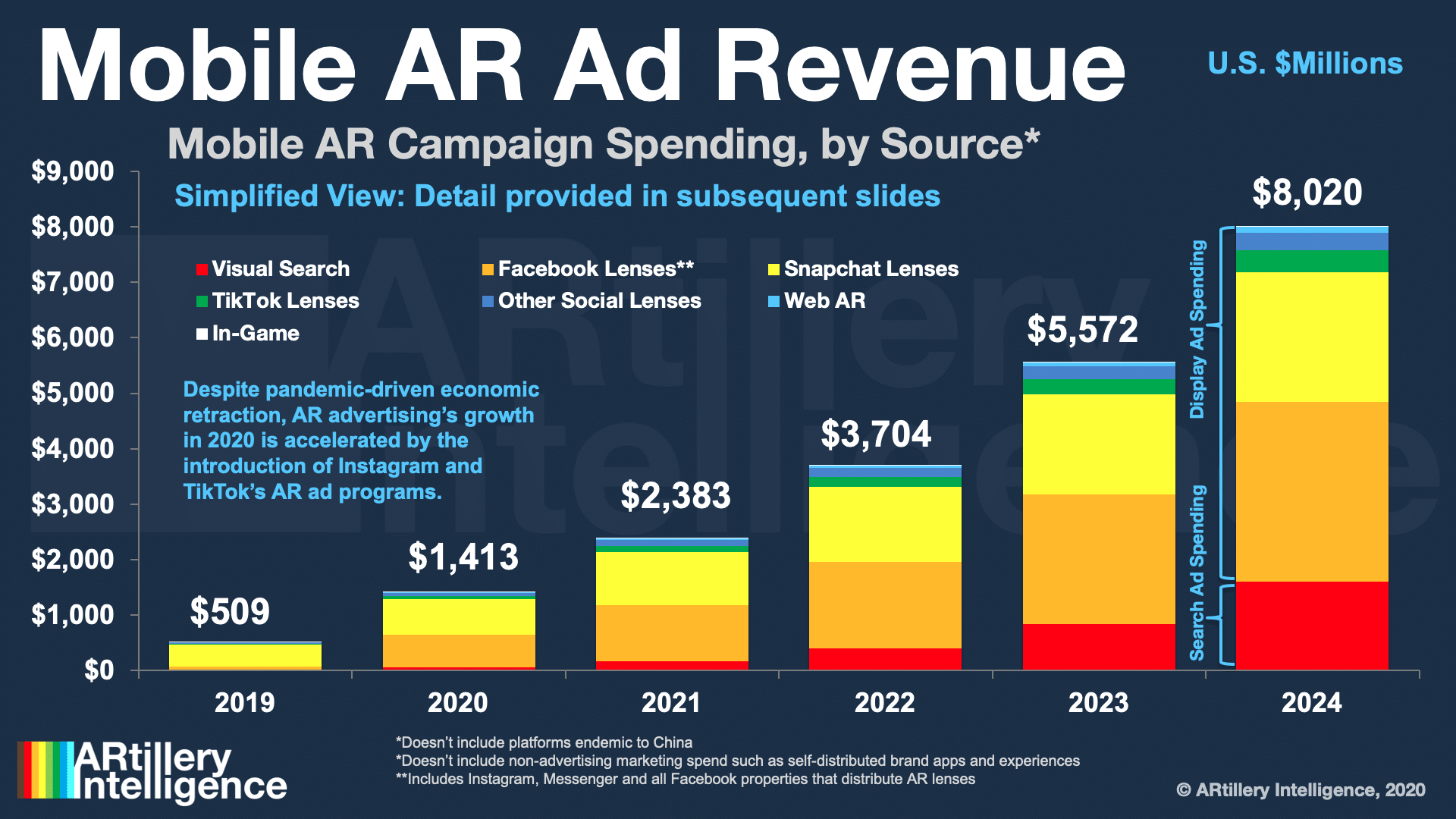
As we approach a new year, it’s time for our annual ritual of synthesizing the lessons from the past twelve months and formulating the outlook for the next twelve. Notably, when kicking off this thought exercise, we realized that several of the topics look similar to last year.
Though there are lots of developments and new insights, the topical containers that house those insights are beginning to coalesce into standard buckets. We’re talking mobile AR engagement & monetization; AR cloud development; enterprise AR and the gradual march of VR.
This standardization is good news in that it signals spatial computing’s exciting – yet insecure – early days have transitioned to an adolescent period of its lifecycle. We have a firmer grasp on what’s working….versus 2017’s wild speculation on the technology’s world-shifting impendence.
So where is spatial computing now, and where is it headed? What’s the trajectory of each of the above subsegments? This was the topic of the latest ARtillery report, Spatial Computing: 2020 Lessons; 2021 Outlook. It looks back and looks forward, including concrete predictions.

Prediction 3: AR Advertising Breaks the $2 Billion Barrier
After examining mobile AR’s scale in our second prediction last week, our third prediction flows from that hardware base.
Stemming from mobile AR’s growing base, the question is what forms of AR are developing, and how are they monetized? For example, one of the most popular forms of consumer AR so far has been lenses, distributed through social channels like Snapchat and Facebook.
These lenses lend themselves to brand sponsorship and paid distribution – a business model propelled by a few factors. Not only is advertising the primary business model of the aforementioned social players, but lenses themselves are conducive to branded experiences.
For example, branded AR lenses in channels like Facebook and Snapchat let consumers visualize products on “spaces & faces” through the smartphone camera. This involves paid distribution, which is similar to, but different than, brands’ self-distributed AR efforts, such as their own apps.
Branded lenses in fact represent one of the leading AR sub-sectors today, with campaign spending estimated to reach $2.4 billion in 2021 according to ARtillery Intelligence’s Global Mobile AR forecast. This total is projected to grow to just over $8 billion by 2024.

Drivers & Dynamics
So what’s driving the above advertising revenue? First, users are demonstrating high engagement with AR lenses as a way to enhance already-popular activities including media-sharing and enhanced selfies. Second, advertisers are attracted to those eyeballs.
Advertisers are also drawn to AR’s ability to let them flex creative muscles and transcend 2D media where they’ve been confined for years. And there’s a strong business case, shown in campaign performance metrics that continue to validate AR advertising’s ROI.
As for who’s doing what to tap into that demand, Snapchat is in the lead, due mostly to its dedicated focus on AR, and alignment with its “camera-company” mission. Facebook also looms large with greater global scale in its flagship app and News Feed distribution.
Facebook also distributes AR through properties like Messenger and Portal. But the real opportunity could be Instagram, where AR aligns with its camera-forward audience and business model. Instagram has already cultivated a product-discovery use case that’s fertile ground for AR.
Meanwhile, wild cards include TikTok which has ample — though uncertain — AR potential. There’s also visual search, which carries the same high user intent that made web search such a strong business. And all of the above will be accelerated by evolving hardware such as LiDAR.

Historical Evidence
The elephant in the room in all of the above is a global pandemic. As is the case across the global economy, mobile AR sectors will be impacted unevenly by ongoing global lockdowns. Given that software mostly fares well in shelter-in-place life, the impact on mobile AR will be mostly positive.
For example, quarantine-friendly consumer AR fare like social lenses are trending up, and social distancing compels enterprise remote-AR support. These factors will boost near-term adoption while exposing the technology….which in-turn supports its longer-term sustained adoption.
But when it comes to advertising, one thing counteracting the above factors is the fact that it’s a famously recession-prone spending category. In the end, AR ad revenues will grow in 2020 but at a slower rate, as estimates have been adjusted down from pre-pandemic projections.
Longer-term, mobile AR advertising could have an advantage as recessions cause advertisers to rethink and redeploy budget to more effective and cost-efficient formats. In fact, this is what happened to search circa-2003 and social advertising circa-2009.
AR could benefit from a similar shakeup by grabbing ad spend. Moreover, brands that try it may discover its virtues and add it to the permanent marketing mix. This cycle is how emerging advertising technologies can inflect, and we expect to see similar with AR in the post-Covid era.
Boiling it Down
To synthesize all of the above into a concrete set of potential market outcomes, here’s what we think will happen in 2021:
— Paid advertising will emerge as AR’s revenue leader in 2021 with a projected $2.4 billion.
— This is driven by Gen-Z’s continued affinity for camera-based experiences, brands’ attraction to 3D product demonstration, and the ROI validation that continues to be seen in AR ad campaigns.
— Hardware evolutions like LiDAR will enable AR lens leaders like Snapchat to offer more robust rear-facing (world-immersive) lens campaigns.
— Though advertising is usually hit hard in recessionary periods, Covid-era factors will have a net positive impact on AR advertising.
— Downturns historically cause advertisers to re-examine and reallocate budget to emerging performance-based ad formats, as seen circa-2003 (search) and 2009 (social).
— AR will benefit from similar factors in 2021 as its existing momentum will inflect with brands’ Covid-accelerated digital transformation.

